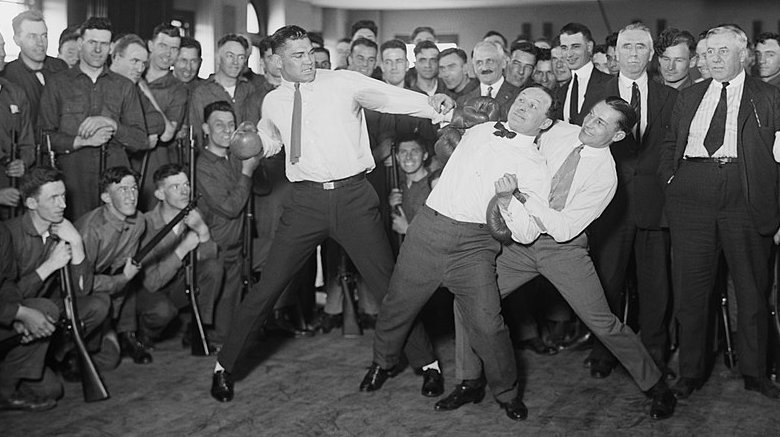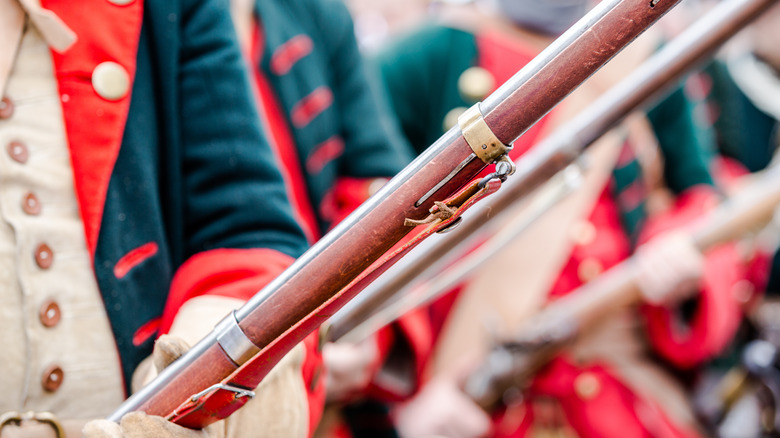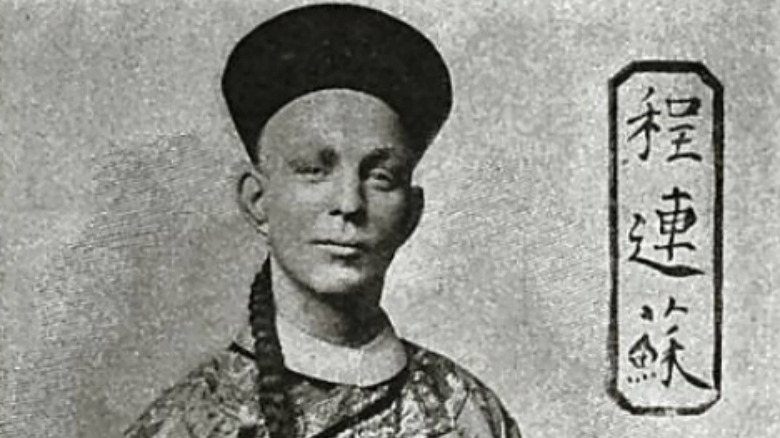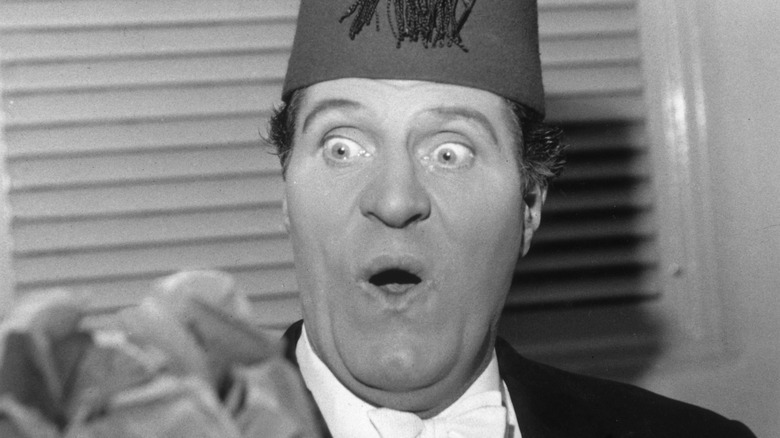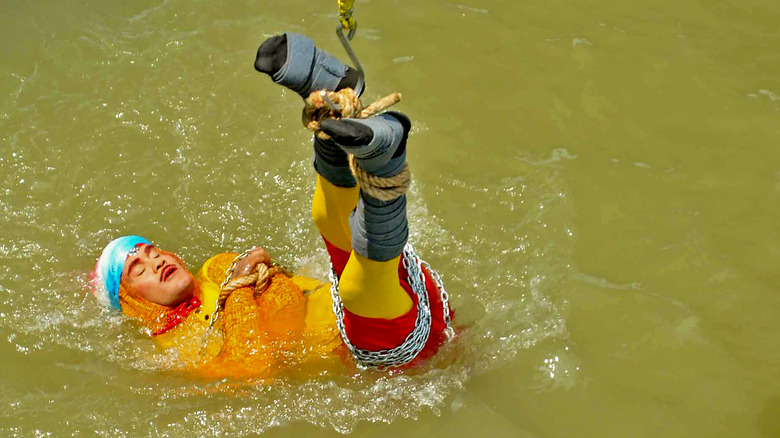Magicians Who Died Trying To Pull Off A Trick
The world of magic can be a very deadly place, and plenty of magic tricks have gone terribly wrong. While safety conditions for many of the industry's most popular entertainers are now better than ever, working as a magician was once one of the world's most dangerous professions. It was all too easy to get burned alive, shot to death, or horribly maimed, or to simply keel over in the middle of a show.
Many years ago, several magicians lost their lives while trying to awe their audiences with their complex illusions and acts of derring-do that involved everything from cutting-edge pyrotechnics to supposedly being able to withstand ridiculous punches. Needless to say, pulling off a trick that involved catching a bullet was much riskier back then than it was when Penn and Teller did it during their modern live shows in Las Vegas. In hindsight, the following magicians should have probably stuck with card tricks or pulling cute rabbits out of their hats.
Harry Houdini
The man many consider the greatest magician of all time died at the age of 52 in 1926. Prior to Harry Houdini's untimely passing, he amazed people all around the world with his astonishing escapes. Handcuffs were no match for him. Neither were milk cans, straitjackets, packing crates tossed into various bodies of water, nor the occasional Chinese water torture cell.
Sadly, Houdini's life came to an end after a nasty encounter with something far less thrilling. According to one account of the events leading to his death, the seemingly superhuman magician was looking through his mail in a dressing room on the afternoon of October 22 when two college students asked to speak with him. One asked Houdini if he could really withstand any heavy blow to his abdomen, as he'd often professed. Houdini said he could. Before he could properly prepare for the trick, though, one of the students punched him four or five times. Houdini was also recovering from a broken ankle, which certainly didn't help matters.
The legendary magician still performed that evening as planned at Montreal's Princess Theatre, but he was suffering badly. After two sleepless nights, he performed one final time on October 24 in Detroit. He barely made it through the show and finally agreed to go to a nearby hospital, where his ruptured appendix was removed. He died there several days later on Halloween, but historians still debate whether it was the student's punches that did him in, or peritonitis, or a combination of the two.
Balabrega
Balabrega was the stage name of John Miller, a Swedish-born magician who moved to the United States as a child in 1868. He began his career at a young age and was billed as "the Boy Magician" during his youth.
As an adult, he toured the world as Balabrega and performed elaborate illusions. He later purchased the rights to one that would prove to be his downfall. It involved six assistants who dressed as moths and would appear to be consumed by flames. Balabrega and his crew traveled to Brazil in 1900 to perform the trick at a theater that didn't have proper safety standards or the equipment they needed, and the magician made the fatal mistake of improvising.
The trick required a supply of gas to fuel the flames. Balabrega instead used acetylene, an unstable chemical that's incredibly flammable. He and one of his assistants were preparing for the show when the acetylene ignited. It badly mangled them both, and they died instantly.
The Great Lafayette
Sigmund Neuberger was born in Munich in 1871 and moved to the United States as a child. Not much is known about his early years, according to The Scotsman. He toured the vaudeville circuit as an expert marksman before switching to magic, moving to London around 1900 and becoming "The Great Lafayette." Neuberger's signature illusion was called the Lion's Bride. It took 25 minutes to perform and involved him magically metamorphosing into a lion.
Despite his immense fame, he was also considered a misanthrope by many and was very attached to Beauty, a dog given to him as a gift by Harry Houdini. Sadly, Beauty died while Neuberger was preparing for a two-week run at the Empire Theater in Edinburgh in 1911. He was so grief-stricken that he predicted that his own death was imminent.
During a performance on May 9, he was getting ready for the final moments of the Lion's Bride illusion when a lamp caught fire. The stage burst into flames, and Neuberger was trapped behind a fire curtain and a series of locked stage doors. The body of his double was later discovered beside a horse and a lion used in the show. A fire crew initially thought it was him, but Neuberger's actual body was recovered a few days later, according to The Edinburgh Reporter. Hundreds of fans showed up to view his coffin as it went through the streets of Edinburgh, and he was buried at Piershill Cemetery beside his beloved pet.
Jeff Rayburn Hopper
Jeff Rayburn Hopper was only 23 years old when he died in 1984 while preparing for an escape trick at Winona Lake in Indiana (pictured). According to The New York Times, he was put in handcuffs and chains before diving into the water on the morning of July 6.
It was all part of a rehearsal for a performance scheduled to take place later that day as part of the Winona Lake Bible Conference. Hopper jumped into the lake about 100 yards from the shore, and he managed to get out of both the chains and the handcuffs before he cried out for his assistant to help him.
Due to high winds, the assistant wasn't able to make it to Hopper in time. Tragically, he drowned in a mere 6 feet of water, the Daytona Beach Sunday News-Journal reported. His body was recovered by authorities about five hours later.
Madame DeLinsky
The bullet catch is one of the oldest and most dangerous tricks in the world of magic, and the illusion often involved real guns when it was performed in the 19th century. This is how Madame DeLinsky met her maker.
She was the wife and assistant of a Polish magician, and together they traveled to the court of a German prince and his family to perform the trick in November 1829. Their version involved recruiting a group of soldiers to act as shills. In those days, loading a rifle typically involved biting open a cartridge, pouring gunpowder into the barrel, and stuffing the cartridge down with a ramrod.
According to contemporary news reports, Madame DeLinsky was reluctant to perform the trick but was essentially badgered into it by her husband. She took her place in front of a "firing squad" of six soldiers who were supposed to pretend to load their rifles with the method described above, secretly removing the musket balls with their teeth. One of them reportedly failed to bite away the deadly projectile and accidentally shot her in the stomach. She died two days later. Even worse, she was pregnant at the time.
Coulen
You should never play with guns. This hasn't stopped plenty of magicians from performing the bullet catch over the years. This famous magic trick is at least 400 years old, and one of the oldest reports of it being performed was way back in the 16th century.
That's when a magician living in Lorraine, France, who went by the name of "Coulen" supposedly did the trick. For reasons unknown, this enraged one of his servants, who beat Coulen to death with the gun, according to a rundown by the Ipswich Magical Society.
There isn't much in the way of solid info on the unfortunate incident, and the few details we do have come from anti-magic religious propaganda — not exactly reliable historical sources. Coulen's fate is mentioned in the pages of "The Theatre of God's Judgement," a religious book written by the English Puritan theologian and clergyman Thomas Beard, which imagines natural disasters, disease, and violent deaths as God's punishment for various transgressions (apparently including the bullet-catch trick). It also appeared in "Wonderful Prodigies of Judgment and Mercy," another Christian text that was first published in the 17th century. His career didn't take off, but at least people talked about the poor guy.
William Ellsworth Robinson, aka Chung Ling Soo
This notorious magician wasn't Chinese and likely never set foot in China. He was actually born William Ellsworth Robinson in New York in 1861. Nevertheless, that didn't stop him from performing magic while in yellowface during an era when this was still considered an acceptable form of entertainment. He even spoke in gibberish he claimed was actually a Chinese dialect.
Robinson initially performed as "Robinson, the Man of Mystery," but his career really took off when he began pretending he was actually a mysterious Chinese illusionist named "Chung Ling Soo." He even came up with an elaborate backstory for his alter ego. Supposedly, Chung Ling Soo was the son of a Scottish man and a Cantonese woman. After they tragically died, he became an apprentice for an illusionist named Arr Hee. He joined Hee on a tour of South America and eventually returned to the Northern Hemisphere where he combined ancient Eastern illusions with more modern European techniques.
Robinson enjoyed a successful career as Chung Ling Soo until the night of March 23, 1918. He was performing a bullet catching trick in London, but some sources claim he had failed to properly clean his trick gun beforehand. According to The Scotsman, Robinson took a bullet to the chest and broke character by uttering, ""My God, I've been shot. Lower the curtain." He died the next day. (David Copperfield reportedly now owns the gun in question.)
Tommy Cooper
Tommy Cooper was a comedy legend over in the U.K. British audiences couldn't get enough of his magic tricks, which he intentionally did poorly. The "magical" Caerphilly-born jokester often wore a fez while performing and enjoyed a decades-long career that came to a tragic end at Her Majesty's Theater on April 15, 1984.
As Wales Online explained, many years of heavy drinking and smoking had evidently caught up with Cooper as he prepared to take the stage for a show that was also broadcast live on the BBC. The theater's crew set up a makeshift dressing room for him offstage so he wouldn't have to climb any stairs. Fellow comedian Jimmy Tarbuck, who emcee'd the show and served as Cooper's assistant that evening, recalled that he looked frail as well.
Cooper fell during his act and suffered a massive heart attack. The audience and Tarbuck assumed he was just joking around — Cooper was known to suddenly improvise during his performances. Several moments passed before he and the stage crew realized something had gone terribly wrong. Tarbuck called for a commercial break before struggling to get Cooper behind the stage curtain, and he was later pronounced dead at Westminster Hospital. "God, that was the saddest night of my entire career," Tarbuck later recalled. Unfortunately, since thousands of people watched the incident on TV that night and VCRs had become commonplace by then, videos of Cooper's tragic death also occasionally pop up on YouTube.
Joseph Burrus
Getting buried alive is one way to get people's attention in the world of magic, but it's also incredibly risky. The infamous escape artist Joseph "Amazing Joe" Burrus learned that lesson the hard way and became a cautionary tale in the process.
Burrus had been buried alive once before in Salem, Oregon, before he arranged an even crazier stunt at Blackbeard's Family Fun Center in Fresno, California. On Halloween night in 1990, he climbed inside a see-through coffin outside the amusement park while dressed in a white tuxedo. He was handcuffed and wrapped in chains as well. "I consider myself a master of illusion and escape artist," he said prior to the stunt, according to The LA Times. "I believe I'm the next Houdini and greater."
In Oregon, Burrus was buried under a pile of dirt. He managed to claw his way out and back to the surface. For the Fresno stunt, his coffin was placed inside a 7-foot-deep hole under both a pile of dirt and a 3-foot layer of wet cement that was collectively estimated to weigh 9 tons. The coffin couldn't handle the load and it collapsed, crushing Burrus in the process. His support crew exhumed him but was unable to save his life. According to the Associated Press, a crowd of 150 people, including Burrus' wife and children, sadly witnessed the whole thing.
Janaka Basnayake
Magician Janaka Basnayake was from Sri Lanka and attempted to break a record for the longest period of time spent buried alive back in 2012. The 24-year-old daredevil joined his family and friends in preparing a trench about 9 feet deep outside the town of Kantale (pictured), about 140 miles north of the island nation's capital. Then he climbed into it on a Saturday morning in March that year.
According to The Guardian, Basnayake was dug up about six hours later. He was unconscious and taken to a hospital, where he was pronounced dead on arrival. Basnayake's mother later said that her son was inspired to perform "unusual acts" due to his infatuation with the world of cinema.
He'd been buried alive twice before. The first time, he lasted 2.5 hours, and he went for six hours during his second attempt. As the BBC later reported, it's unclear if there's ever been an official world record for the longest amount of time spent while being buried alive, and considering how dangerous it is, it should probably stay that way. Most of the people who were buried alive and lived to tell the tale certainly didn't volunteer for the gig.
Chanchal Lahiri
Harry Houdini is long gone, but that hasn't stopped the wannabes from trying to copy his most famous stunts. Except that Houdini's bits weren't just smoke and mirrors; they were genuinely dangerous stunts and they weren't designed for amateurs or even for most pros. That means duplicating a Houdini stunt might make you famous or it might make you dead, and no one's going to act super surprised if it ends up being the latter.
In 1912, Scientific American (which evidently wasn't always all about, you know, science) declared Houdini's underwater box escape to be "one of the most remarkable tricks ever performed." In June 2019, Indian magician Chanchal Lahiri (stage name "Jadugar Mandrake" or "Wizard Mandrake") was trying to perform a similar trick when something went wrong. Eyewitnesses said Lahiri — dressed in a bright red and yellow costume — had his arms and legs bound with ropes and chains and was lowered into the Hooghly River in Kolkata. He was expected to resurface just moments later, but he wasn't seen again until the following day, when authorities pulled his body out of the river. According to the Times of India, Lahiri made "several mistakes," including underestimating the current and wearing clothing and gear that would have hindered his ability to swim.
Weirdly, Lahiri's team waited a full 15 minutes to raise the alarm — plenty of time and then some for a man bogged down by chains and rope to drown in the murky waters.

